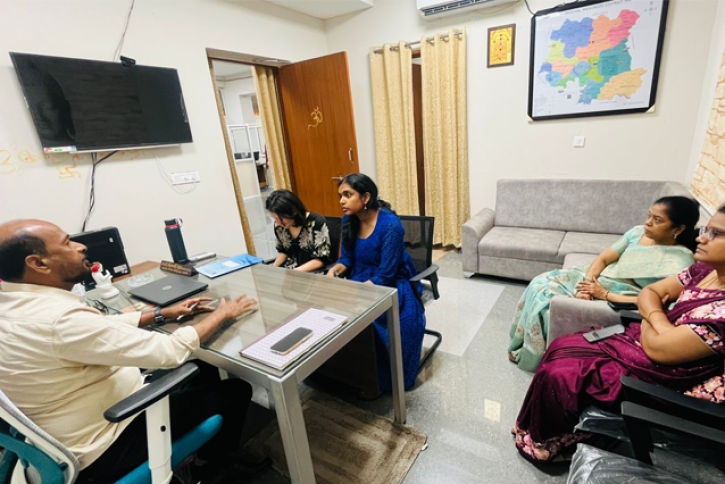
Srihitha Dasari ’26 (center) conducted independent research on cesarean section rates in Telangana, India, through MISTI South Asia.
A few years ago, Katherine Hobgood ’25 never would have dreamed of traveling alone internationally.
Now, she’s an environmental educator in Guyana with the Peace Corps.
Hobgood’s journey of confidence and global experience began with the MIT International Science and Technology Initiatives (MISTI), housed at the Center for International Studies (CIS) within the School of Humanities, Arts, and Social Sciences. For more than four decades, MISTI has been helping students bridge the gap between academic discovery on campus and learning in dozens of countries worldwide.
In summer 2023, Hobgood traveled to Bangalore, India, to study at the National Centre for Biological Sciences. She examined chemical markers in tiger urine samples alongside ecology researchers. Next, she spent her fall semester conducting fieldwork at Green Up Gambia, which addresses climate change mitigation in rural villages. Most recently, she completed an environmental policy internship at Horticulture New Zealand.
Hobgood’s father, a development worker conducting US government projects on climate change around the world, inspired her to travel internationally. “One of my dreams was to go to the Peace Corps,” she says. “Throughout the interview process, I referred back to my MISTI experiences. A lot of the questions were about cultural adaptation and professionalism in new cultures. MISTI was invaluable.”
MISTI also gave her confidence. “In India, on one of my off weekends, I booked my own bus, took a trip to another part of India on my own, and did it safely. This was the first time I’d ever done that. It completely changed everything for me: It made me comfortable with solo traveling and going to places that I don’t know all that much about,” she says.
Global outlook for global challenges
“MISTI was started around the idea that, in order for engineers to be impactful in the world, they also need to learn from companies around the world,” says MISTI faculty director Evan Lieberman, the Total Professor on Contemporary Africa and director of the CIS.
The program launched in 1983 with a focus on Japan, then one of the world’s primary innovation hubs. The success of MISTI Japan, under the leadership of Richard Samuels PhD ’80, Ford International Professor of Political Science, served as a template for future MISTI opportunities. In 2018, Richard Lester PhD ’80, the Japan Steel Industry Professor and MIT’s former vice provost for international activities, underscored a commitment to offering international, experiential education to every MIT student who desired it, giving MISTI even more momentum and broader reach.
“MISTI is really trying to help MIT fulfill that mandate,” Lieberman says. International study takes on special importance at MIT, he explains, because many students want to wring out every possible moment on campus.
“Most students really want to spend all eight semesters at MIT to get the technical training that they came here for. They don’t feel like they can disrupt that. They don’t want to leave,” Lieberman says.
MISTI makes it possible for students to travel beyond Cambridge without sacrificing the rigor of an MIT education. Now, more than half of undergraduates study internationally through MISTI in more than two dozen countries with a goal of helping to find solutions for some of the world’s biggest challenges—MISTI hosts more climate-related internships than any other campus organization. Other popular areas include AI, social impact, and health care.
A fresh outlook, in the lab and beyond
Health care is a focus for neuroscience major Amy Wang ’26, who hopes to pursue medicine and potentially obtain a master’s degree in public health. As a Spanish minor, she also wants to become fluent to improve her practice. She recently conducted a MISTI summer internship at the Neurobiology Institute at the National Autonomous University of Mexico.
There, she sharpened her language skills. But, just as important, she learned how laboratories function in other countries. While she’d spent plenty of time in US laboratories working with mice, it was eye-opening to explore how other countries conducted research.
“In their labs, they do very detailed habituation processes. You’re working with mice for a while before you even start your experiments. You get to hold them, and they crawl around your arms as they get more comfortable with you. It was just a really sweet moment of connection that I hadn’t had with animals I worked with before,” she recalls.

